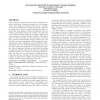Free Online Productivity Tools
i2Speak
i2Symbol
i2OCR
iTex2Img
iWeb2Print
iWeb2Shot
i2Type
iPdf2Split
iPdf2Merge
i2Bopomofo
i2Arabic
i2Style
i2Image
i2PDF
iLatex2Rtf
Sci2ools
IMC
2004
ACM
2004
ACM
On scalable attack detection in the network
Current intrusion detection and prevention systems seek to detect a wide class of network intrusions (e.g., DoS attacks, worms, port scans) at network vantage points. Unfortunately, all the IDS systems we know of keep per-connection or per-flow state. Thus it is hardly surprising that IDS systems (other than signature detection mechanisms) have not scaled to multi-gigabit speeds. By contrast, note that both router lookups and fair queuing have scaled to high speeds using aggregation via prefix lookups or DiffServ. Thus in this paper, we initiate research into the question as to whether one can detect attacks without keeping per-flow state. We will show that such aggregation, while making fast implementations possible, immediately cause two problems. First, aggregation can cause behavioral aliasing where, for example, good behaviors can aggregate to look like bad behaviors. Second, aggregated schemes are susceptible to spoofing by which the intruder sends attacks that have appropr...
DoS Attacks | IDS Systems | IMC 2004 | Per-flow State |
| Added | 30 Jun 2010 |
| Updated | 30 Jun 2010 |
| Type | Conference |
| Year | 2004 |
| Where | IMC |
| Authors | Ramana Rao Kompella, Sumeet Singh, George Varghese |
Comments (0)

